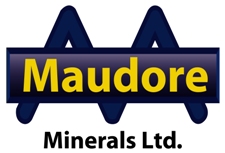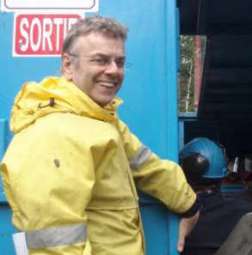|
JUNIOR GOLD STOCK |
|
|
2011 |
||
|
The Most Powerful Name In Corporate News and Information |
||
|
Energy | Resources | Capital Goods | Healthcare | Financial | Technology | Communications | Business Services |
||
|
CURRENT ISSUE | COVER ARCHIVES | INDEX | CONTACT | FINANCIALS | SERVICES | HOME PAGE |
||
|
3.2 g/t Gold in the Potential Open Pit Portion of Maudore's 1.2 Million Ounce Resource in Quebec Separates Maudore From Its Peers - Other Open Pits Currently in Development Run About 1 g/t Gold, Offering Maudore Three Times the Grade, Thus Much Lower Potential Costs |
||
|
Jr. Oil & Gas
DBRM
Jr. Gold AEX
Drug Development BPAX
Health & Wellness
SMEV
Insurance MIG
Technology ANDR
Business
Services PRGX
Canadian Resource LAT
|
Maudore Minerals Ltd. (TSX-V:
MAO, OTCBB: MAOMF) owns 100% of the Comtois Gold
Project in Quebec, Canada and is focused on developing this resource.
Maudore also owns a large land package west of Comtois with volcanogenic
gold/massive sulphide (VMS) potential.
Local infrastructure is excellent: a highway; accessibility to North
America's lowest cost power; plenty of nearby water; and a mining-oriented
local workforce. Quebec is consistently ranked among the best locations
worldwide for mineral exploration. A 47% cash rebate on in-ground
expenditures, unique to Quebec, enables highly cost-effective and aggressive
exploration.
Mr. Shorr: The major event for Maudore this year was the revision of our 43-101 resource report. Eight years ago, Maudore produced a 43-101 report showing 524,000 ounces of gold, uncut. The new report indicates 1.2 million ounces, using a top cut of 65 grams per tonne. Our deposit is very high grade, and the new report provides a more conservative statement, about 200,000 ounces less than if all our higher-grade intercepts were taken into account. About 40 drill intercepts from all parts of the deposit reported grades above 65 g/t, so it’s pretty likely they’re not just statistical anomalies. The new report shows that a large portion of our resource, over half a million ounces, are very shallow and therefore pretty easy to develop as an open pit at a grade of 3.2 g/t; this is about 3 times the industry average for open pit gold mines, another indication that our deposit has excellent grades and that a future operation has a good shot at robust returns even if gold prices dropped substantially. Since the new resource was calculated, we have drilled more than 200 new holes, many with high grades, so the project’s gold ounces are still growing substantially. In our October 2010 press release, drill results included an intercept of 453.5 grams, one of our best yet. So things are looking very well for Maudore this year.
CEOCFO: Did you do a lot of drilling last year? Mr. Shorr: Yes, as a matter of fact, in 2010 we drilled 82,500 meters. This likely puts us in the top 5% of all mining companies in terms of drilling activity and by that I am including major mining companies in that number also. We’ve generally had four drill rigs operating for the entire year - every week of the year except Christmas week. Drilling is the only way to prove up gold, and we are on a mission here.
CEOCFO: Did you suspect it was going to be such a great project? Mr. Shorr: I got involved with Maudore because I thought it was a great project with lots of potential, and our drilling success since then indicates that I might be right. A year or two ago the project looked like two isolated pods that might grow. However, starting in 2009 and continuing into 2010, we’ve pretty much proved the connectivity of these two pods, and now it looks like we have an almost a 2 kilometer strike length with a semi-continuous strip of gold. We’re continuing to expand the known zones, and fill in the existing gaps, to support that theory.
CEOCFO: Did you have some new claims as well this year? Mr. Shorr: In early December we added about 50% to our claim package. We are looking forward over the long term to doing a lot of drilling to investigate the potential for VMS (volcanogenic massive sulphide) gold deposits in the new areas. Virtually all of our drilling in the past few years has been confined to our core area, about 2 kilometers in length, but our property now extends roughly 100 kilometers westward from where we’re doing our drilling. The newer properties were acquired based on a number of positive indicators, and we intend some future focus on exploring the potential of that expanded land package while continuing to develop our core area.
CEOCFO: Do you anticipate picking up more land or are you set for now? Mr. Shorr: We have an active claims management division of the company that picks up land on an ongoing basis. Most recently, we optioned a large group of about 530 new claims. The Quebec government makes the claims process very straightforward, and often provides some geological information and occasionally drilling efforts as well.
CEOCFO: Do you own your property 100%? Mr. Shorr: We own 100% of the mineral rights on almost every piece of land that we have.
CEOCFO: Drilling is usually expensive; what is the financial picture like for Maudore Minerals today? Mr. Shorr: Here, we’re in a great position - drilling is relatively inexpensive for us: Quebec gives us back 47% of all the funds that we put into the ground, by which I mean money spent on drilling, assays, and field geology. On top of that, we were fortunate enough to have made a long-term deal with a driller back in the summer of 2009 when the world was talking about a potential depression. However, there was enough confidence on my part and other people associated with the project that we were willing to commit to 70,000 meters of drilling with one drilling company at an all-in cost of $58 per meter. So with our rebates that really comes out to about $30 per meter. In neighboring provinces like Ontario, it would cost typically more like $100-$125 per meter and in Nevada you can almost double that to $225 per meter, about the same cost as in Africa and Latin America. Also, we have roughly $7 million in the bank to continue drilling. So, we are pretty well set going into 2011.
CEOCFO: What is the timetable and what do you see in the next year or two? Mr. Shorr: In the core project, we’re going to drill out areas that were not credited with having gold in the 43-101 resource. We are going to prove up the open-pit potential and the metallurgy of the deposit. We’ll look into things like strip ratio, recovery estimates, and moving the project closer and closer to production by possibly doing things like preliminary economic analysis and a pre-feasibility study.
CEOCFO: Is the investment community paying attention? Mr. Shorr: It is surprising how often I am told that Maudore is still completely under the radar screen of some major investors. This isn’t necessarily entirely negative. Certainly, it means that as our profile lifts there’ll be a new audience for the Maudore story, especially our key advantage of having high-grade gold in Quebec. For example, our potential open-pit ounces have an average grade of 3.2 grams, and most open pit deposits in the world are going into production at roughly 1 gram, which happens to be our cut-off. In other words, we are hoping to develop an extremely low cost, very high grade open pit, which has access, only a mile, or so away, to the lowest cost power in North America. Mining is an industry which consumes large amounts of power and we are positioned to great advantage regarding this key factor.
CEOCFO: What should people remember most when they read about Maudore Minerals? Mr. Shorr: Hopefully, our ticker symbol! It is MAO and that does not mean we are located in China; we are in Quebec! We have a very tight market capitalization of about 26 million shares fully diluted and that puts us in a somewhat unique class. MAO is almost 75% held by institutions and insiders – I personally hold 7% of our stock. I think the most important things to remember about Maudore include our location and excellent infrastructure in Quebec, our extraordinarily high gold grades, and our aggressive growth plans.
|
From The Exploration And
Production Of Lithium To Partnering For Manufacturing, Lomiko Metals
Inc. Is Developing Into A Fully Integrated Battery Company |
|
Access thousands of full-text Public
Company CEO & CFO Interviews!
|
||
|
The major event for Maudore this year was the revision of our 43-101 resource report. Eight years ago, Maudore produced a 43-101 report showing 524,000 ounces of gold, uncut. The new report indicates 1.2 million ounces, using a cut-off of 65 grams per tonne. Our deposit is very high grade, and the new report provides a more conservative statement, about 200,000 ounces less than if all our higher-grade intercepts were taken into account. About 40 drill intercepts from all parts of the deposit reported grades above 65 g/t, so it’s pretty likely they’re not just statistical anomalies. The new report shows that a large portion of our resource, over half a million ounces, are very shallow and therefore pretty easy to develop as an open pit at a grade of 3.2 g/t; this is about 3 times the industry average for open pit gold mines, another indication that our deposit has excellent grades and that a future operation has a good shot at robust returns even if gold prices dropped substantially. Since the new resource was calculated, we have drilled more than 200 new holes, many with high grades, so the project’s gold ounces are still growing substantially. In our October 2010 press release, drill results included an intercept of 453.5 grams, one of our best yet. So things are looking very well for Maudore this year. - Ronald Shorr, CFA |
||

